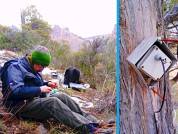Practical step-by-step recipe to construct low-cost point dendrometers
DOI:
https://doi.org/10.25260/EA.20.30.2.0.1080Keywords:
radial growth, stem, potentiometer, calibration, data loggerAbstract
Automatic point dendrometers are measuring equipment used in forestry to measure variations in the stem of trees in high spatial and temporal resolution. This information has a high level of detail and is relevant to assess the factors and conditions governing the contraction, expansion and growth of stems. This is due to balances of water content in the stem and cell division of the cambium. Variations of climate, competition for resources and human activity may influence the growth of the stem. This work proposes the step-by-step construction of a point dendrometer at a lower cost than would imply the acquisition of commercial equipment. For this, a series of component elements is listed, as well as the assembly procedure and calibrations carried out by the workgroup, and the comparative tests with commercial dendrometers. Preliminary results show it is feasible to assemble dendrometers from their component parts and that there is a similarity of records between developed and commercial equipment. This may allow large-scale phenotyping of the stem growth, at a significantly lower cost than acquiring commercial equipment.
References
Biondi, F., and P. Hartsough. 2010 Using Automated Point Dendrometers to Analyze Tropical Treeline Stem Growth at Nevado de Colima, Mexico. Sensors (Basel) 10(6):5827-5844. https://doi.org/10.3390/s100605827.
Daniel, T. W., J. A. Helms, and F. S. Backer. 1982. Principios de Silvicultura. México. Mc Graw-Hill. Pp. 492.
De Belder, A. 2015. Comparison of different dendrometers and LVDT-sensors in laboratory and field conditions. Masterproef voorgedragen tot het behalen van de graad van Master in de bio-ingenieurswetenschappen: Milieutechnologie. Faculteit Bio-ingenieurswetenschappen. Universiteit Gent. Germany. Pp. 50.
Deslauriers, A., S. Rossi, and T. Anfodillo. 2008. Cambial phenology, wood formation and temperature thresholds in two contrasting years at high altitude in southern Italy. Tree Physiol 28:863-871. https://doi.org/10.1093/treephys/28.6.863.
Drew, D. M., and G. M. Downes. 2009. The use of precision dendrometers in research on daily stem size and wood property variation: A review. Dendrochronologia 27(2):159-172. https://doi.org/10.1016/j.dendro.2009.06.008.
Ecomatik. 2019. Catalog about Plant growth, Sap flow, Leaf Temperature and Soil Moisture. URL: tinyurl.com/yachd3bu.
Edaphic Scientific. 2017. Dendrometers: Multi-Purpose Sensors. URL: tinyurl.com/ybmpu8lb
Fernandes, R., V. Hernández Santana, and M. Cuevas Sánchez. 2018. Are fruit dendrometers reliable to schedule irrigation in olive trees? Olive Management, Biotechnology and Authenticity of Olive Products. Olivebioteq 2018:T06-P3.
King, G., P. Fonti, D. Nievergelt, U. Büntgen, and D. Frank. 2013. Climatic drivers of hourly to yearly tree radius variations along a 6 °C natural warming gradient. Agricultural and Forest Meteorology 168:36-46. https://doi.org/10.1016/j.agrformet.2012.08.002.
Mac Donald, J. E., and J. N. Owens. 1993. Bud development in coastal Douglas-fir seedlings under controlled-environment conditions Canadian Journal of Forest Research 23(6):1203-1212. https://doi.org/10.1139/x93-152.
Pesonen, E., K. Mielikäinen, and H. Mäkinen. 2004. A new girth band for measuring stem diameter changes. Forestry 77:431-439. https://doi.org/10.1093/forestry/77.5.431.
Schweingruber, F. H. 2007. Wood Structure and Environment. Springer. Pp. 85.
Shestakova, T. A., E. Gutiérrez, A. V. Kirdyanov, J. J. Camarero, M. Génova, A. A. Knorre, J. C. Linares, V. Resco de Dios, R. Sánchez-Salguero, and J. Voltas. 2016. Forests synchronize their growth in contrasting Eurasian regions in response to climate warming. Proceedings of the National Academy of Sciences 113(3):662-667. https://doi.org/10.1073/pnas.1514717113.
Siegmund, J. F., T. G. M. Sanders, I. Heinrich, E. van der Maaten, S. Simard, G. Helle, and R. V. Donner. 2016. Meteorological Drivers of Extremes in Daily Stem Radius Variations of Beech, Oak, and Pine in Northeastern Germany: An Event Coincidence Analysis. Front. Plant Sci 7:733. https://doi.org/10.3389/fpls.2016.00733.
UP GmbH Firmensitz. 2019. Fruitquality-Size. URL: tinyurl.com/ybwsjz4g.
Wang, J., and T. W. Sammis. 2008. New automatic band and point dendrometers for measuring stem diameter growth. Applied Engineering in Agriculture 24(6):731-742. https://doi.org/10.13031/2013.25361.
Zhang, R., Y. Yuan, X. Gou, T. Zhang, C. Zou, C. Ji, Z. Fan, L. Qin, H. Shang, and X. Li. 2016. Intra-annual radial growth of Schrenk spruce (Picea schrenkiana Fisch. et Mey) and its response to climate on the northern slopes of the Tianshan Mountains. Dendrochronologia 40:36-42. https://doi.org/10.1016/j.dendro.2016.06.002.

Downloads
Additional Files
Published
How to Cite
Issue
Section
License
Copyright (c) 2020 Juan P. Diez, Manuel De Paz, Santiago A. Varela, Guillermina Dalla Salda, Anne S. Sergent, Alejandro Martínez Meier

This work is licensed under a Creative Commons Attribution 3.0 Unported License.
Authors retain their rights as follows: 1) by granting the journal the right to its first publication, and 2) by registering the published article with a Creative Commons Attribution License (CC-BY 4.0), which allows authors and third parties to view and use it as long as they clearly mention its origin (citation or reference, including authorship and first publication in this journal). Authors can make other non-exclusive distribution agreements as long as they clearly indicate their origin and are encouraged to widely share and disseminate the published version of their work.


